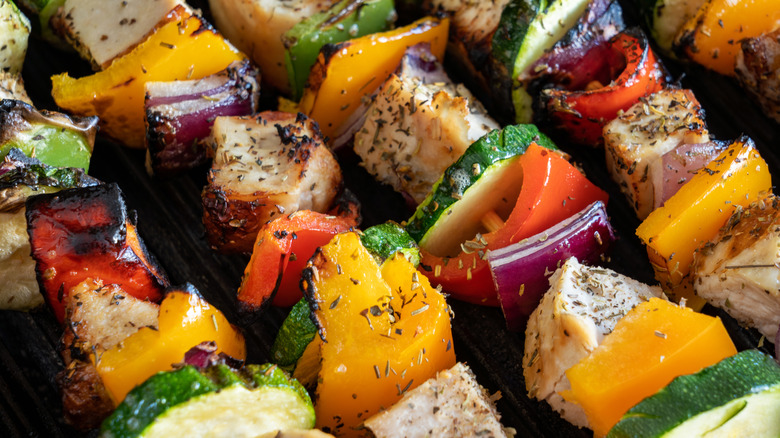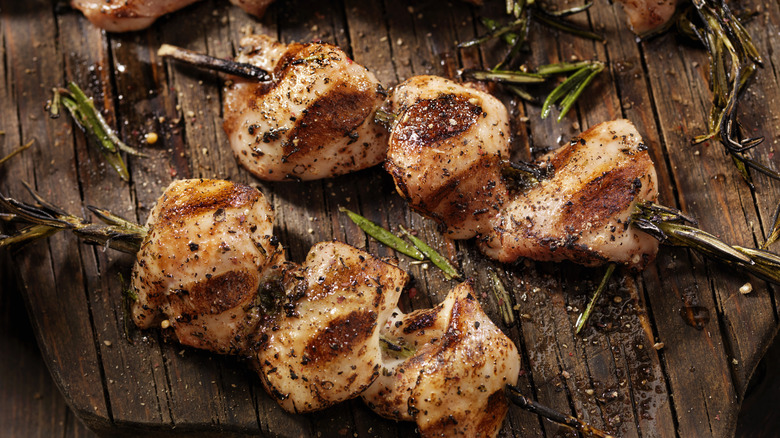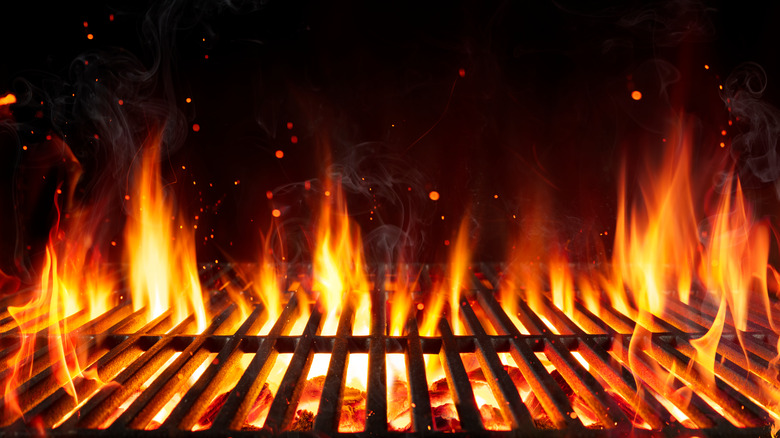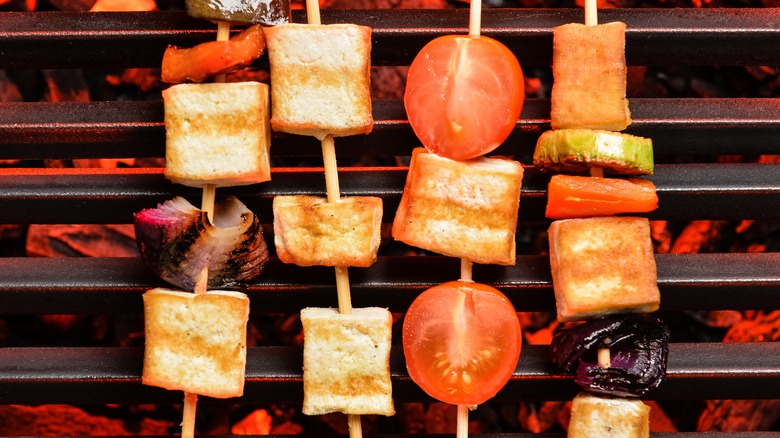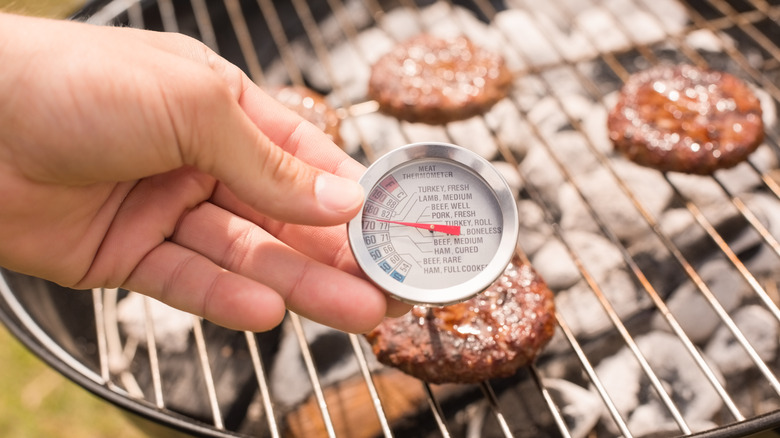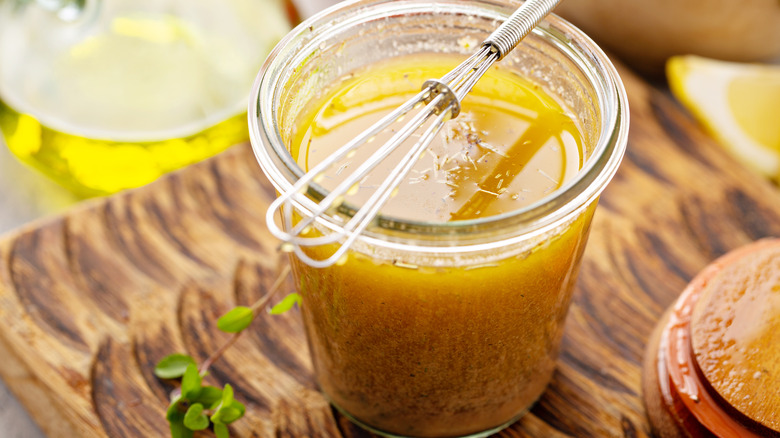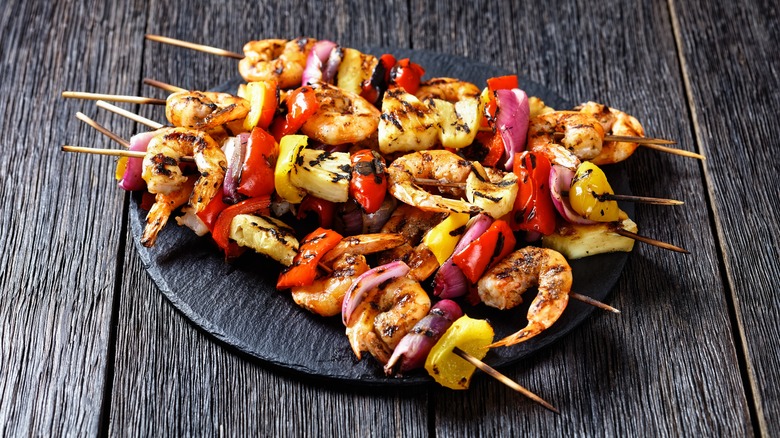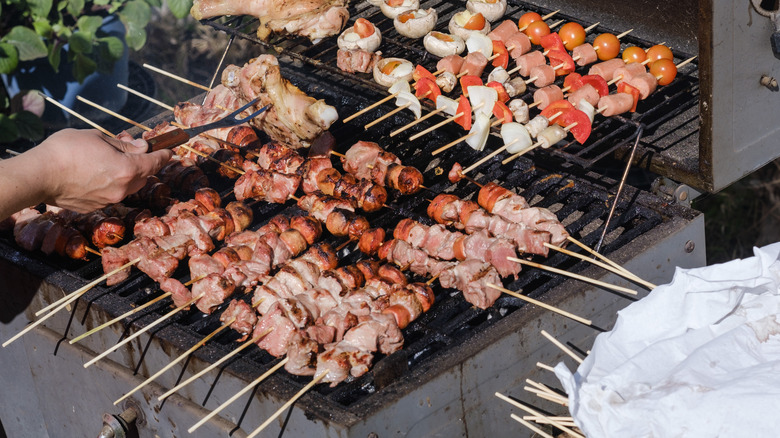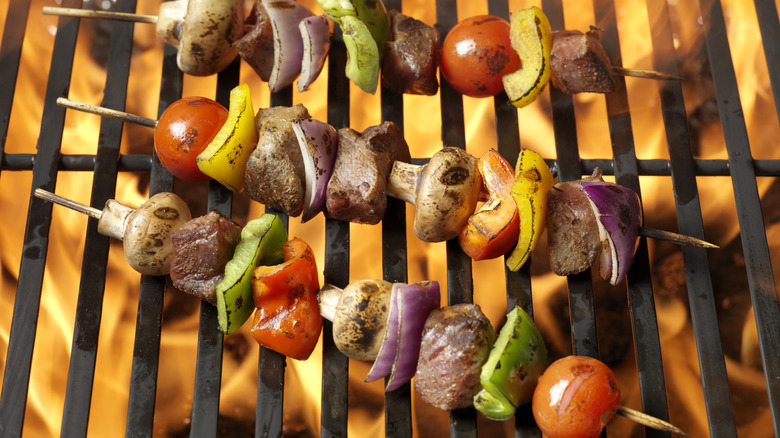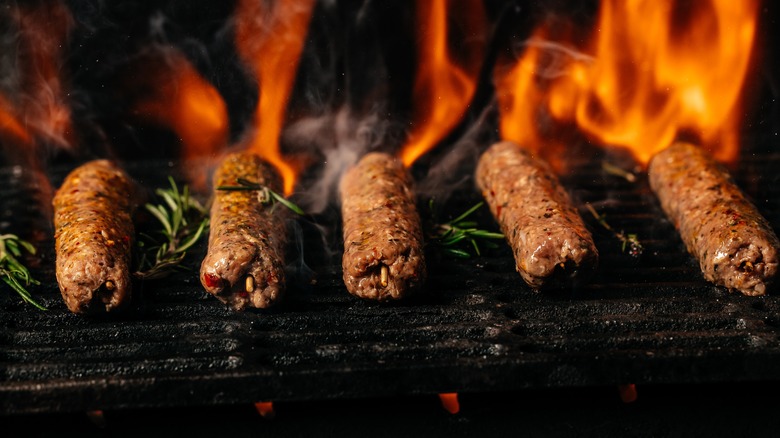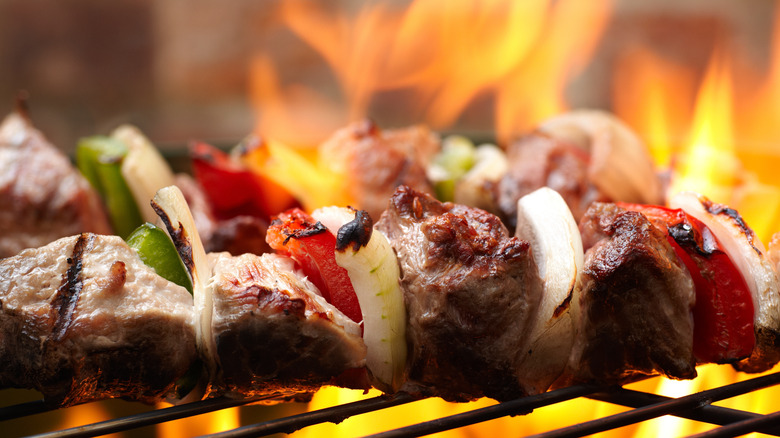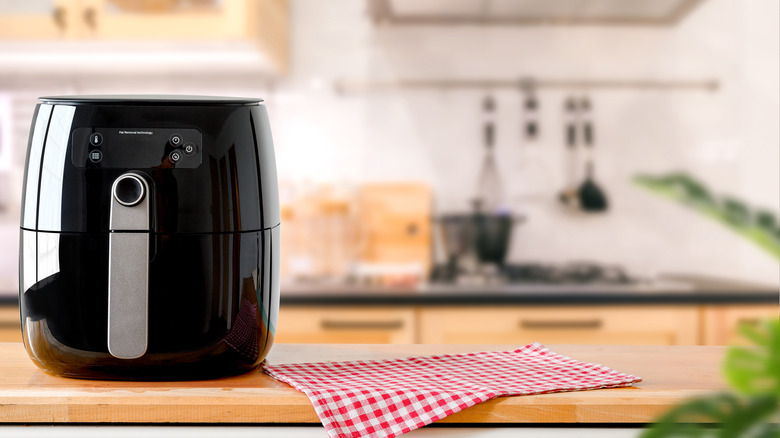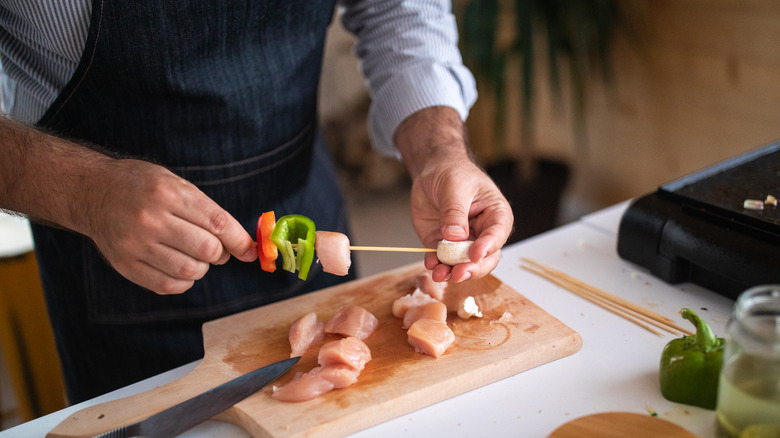14 Essential Tips For Grilling Kabobs
Summertime brings with it the inviting smell of the grill, and there are few food staples that are more strongly associated with the open flame than kabobs. Easy preparation, versatility, aesthetic appeal, and deliciousness all combine to make these carefully arranged skewers massively popular among foodies and casual consumers. While the popular kabobs in the Western world could be reduced to simply being "meat and veggies on a stick," kabobs thrive when their preparer keeps a sense of imagination and care throughout the process. Sometimes that means taking a little extra time to marinate to perfection, while other times it means considering details down to the skewer to make the end result all it can be.
While kabobs are relatively straightforward, the sheer number of options available in terms of what ingredients to use, how to prepare them, and how long to cook them mean that they aren't always the most intuitive thing to whip up on the fly. While burgers and hot dogs have their place, kabobs are one secret ingredient to make any backyard gathering come alive. To that end, we have some easy-to-remember tips and tricks that will help you take this deceptively simple food from good to great at your next outdoor grill.
Consider cooking meat and veggies separately
Anyone who has had kabobs in the past will recognize the carefully positioned meats and veggies artfully arranged to be both optically pleasing and delicious. However, one major tip for preparing these skewers is to consider cooking the proteins and the veggies separately. This may seem counterintuitive at first considering how established the visual patterns of kabobs are, but hear us out. While you can arrange the items however you desire after the grilling is complete, cooking these items separately may unlock the taste profile that you're looking for while adding a negligible amount of time to the process.
The biggest reason to do this is that different foods cook at different times, so using cubes of chicken next to other popular kabob items like red peppers or mushrooms doesn't necessarily make sense. While it cuts out the step of rearranging them when they come off the grill, it practically ensures that something on the skewer is going to be either over or undercooked. While most of us have enjoyed skewers that were cooked all together in the past, try this one trick a few times and it'll be hard to imagine going back. Allowing meat and veggies to cook on their own separate schedules is just one more step for quality control that can make kabobs taste even better.
Prep the grill
As any grillmaster will tell you, operating the open flame is a matter of finesse. While straightforward in concept, the volatile nature of the heat source and an outdoor environment make grilling a tempestuous cooking medium, but there are some simple steps to take to make the process a whole lot easier. Perhaps the most crucial step to prepare well before the cooking process begins is to make sure you have all of the grill-specific equipment you need. Items like cooking gloves, tongs, and torches to help you manage flame are all going to work wonders for your grilling experience. Finally, try to plan ahead for what material you're using to fuel the flame, as wood, coal, and gas all have their own quirks and assets.
Getting the grill ready for the kabobs is also vital. Start with emptying any remaining ash from your last backyard gathering, make sure the grates are clean, and then preheat them by starting up the flame 10 to 15 minutes before you plan to begin cooking your kabobs. After the grate is hot and you're about to begin, take a moment to use your tongs to carefully drag an oiled paper towel thoroughly over the grate. This will keep your food from sticking to the metal.
Be choosey with your protein
There are so many different ways to prepare a kabob that the sky truly is the limit, but the main choice to make is which protein will be the star of your skewer. Figuring out what food item you're basing your kabobs around is going to make it a lot easier to follow it up with a complimentary series of supporting characters to make a winning combination. Using tofu as a protein? Then you might skip the mushrooms and lean into zucchini and peppers. Trying shrimp this time around? Think about adding pineapple to compliment it.
Everything down to the backing ingredients and the amount of time the grilling process takes will hinge on which protein you use, but that's definitely something you can shape to your advantage. Likewise, it encourages you to add your own flare to the mix. While most people have tried staples like chicken on a kabob, what about turkey kofta kabobs, or eggplant and red onion? Buying the best ingredients is always going to make for a more satisfying meal, and that's especially true when it comes to protein. While the level of choices available may be daunting, the decision you make will help keep the planning process smooth.
Use a meat thermometer
There are so many reasons to use a meat thermometer when cooking that it's an article in itself, but we can cover a few. For starters, under or overcooking are very common mistakes that beginners and seasoned pros alike can make without having a handy guide to help them. Trying to judge how hot the middle of something is by looking at its surface is just not a great way to go about it. Fortunately, meat thermometers are cheap, easy to track down, and simple to use, meaning that there's really no excuse not to make good use of them when you're working the grill this summer.
Sure, most people associate thermometers with denser fare like a Thanksgiving turkey, but they're handy for just about anything you prepare at home. Not only does this help with quality control, but it can also boil down to being a matter of safety. Foods like chicken are notoriously in danger of the ill effects of bacteria, and summer heat doesn't help. Another reason to use a meat thermometer is basic control. The more control you have in the cooking process, the less potential there is for chaos, and when you're dealing with food and flame that's always a good thing.
Be mindful of time and taste when marinading
We've already mentioned the importance of which protein you choose, but the thing that's going to make that item pop is the marinade, the secret MVP of every perfect kabob. Each ingredient combination has its own ideal flavor profile, and marinade is absolutely crucial to bringing that to the surface. Likewise, the extra moisture is going to be a godsend to your kabobs as they sit over the heat of the grill, keeping your skewers from drying out or toughening up while allowing the flavor to soak into your protein of choice. How long you marinate will depend on your protein and can span from half an hour to a whole day, so be sure to do your research.
While your choices for which marinade to use are many, there are a few universal tricks that we can share to help you along the way. A simple equation to follow when creating a marinade is to measure one part acid and three parts fat or oil. Examples of acids you might use include vinegar, wines or beers, or lemon or lime juice, while popular oils include olive or sesame, but could also entail items like yogurt or buttermilk. Finally, add seasonings to the mix, and that could include dried herbs or liquid condiments like catsup and mustard. Which unique combination you choose is up to you, but that simple formula will help you achieve grill greatness.
Don't skip the seasoning
After putting so much thought into creating your perfect marinade, you may feel that you've got your kabobs on lock, but there's one more step that could help in your preparation process, and that's seasoning. Yes, you may have already added seasoning to the marinade itself, but that doesn't mean you should skip adding a little extra before placing your skewers on the grill. Rubs and spice blends are ideal to heighten the work that the marinade is doing, and it's just one more thing you can do to make even the most ordinary-seeming kabob more memorable with very little effort.
As for what seasoning to use, this is another choice that runs the gamut of options, but even just starting with a simple salt and pepper shake over is going to work wonders for the end result. Other common spices include garlic, Italian seasoning, and paprika, but slightly more offbeat choices like cinnamon and turmeric can make a world of difference to your kabobs. Besides the taste benefits, the spices you use will keep the outer layer of your foods dry, which will add to the aesthetic appeal as they sear and add color to your skewers.
Never be afraid to experiment
While a lot of us have a standard image in our minds of the perfect kabob, the fact is that the versatility of this entree is exactly what makes it so special. You can't go wrong with a typical grilled chicken and peppers combination, but if that's the only amalgam you try in your life, you're only experiencing a sliver of all kabobs can be. While choosing which protein and marinade are key decisions in this process, a big part of the joy of grilling kabobs is the sense of creativity that can come from trying a new spin on your old favorites or adding a seasoning that you never tried before.
If you're looking for off-the-beaten-path kabob recipes to try these sweet but savory Turkish pomegranate beef skewers. The internet is overflowing with suggestions for different kabob arrangements, and if you don't like one, there's always going to be another that you love. While there is something to be said for the comfort of a tried-and-true recipe, trying things we might not have previously thought of is how we discover new favorites, and kabobs are an arena particularly rife for experimentation.
Timing is everything
The best and worst thing about kabobs is that there is no universal set of rules when it comes to preparing them — you can make them with pretty much anything that will hold together on a stick and, as noted above, there are endless combinations of sauce and seasonings to try. Which ingredients you choose will help you with one of your most important steps, which is how long to marinade, and how long each kabob needs to spend on the grill. This isn't a one-size-fits-all situation in the slightest, but we have a few tips to light the path.
Fish and vegetables are both relatively fast to grill, with either generally requiring about ten minutes to reach the ideal temperature and consistency. Chicken and beef will need to cook for closer to 15 minutes, but even these estimates depend on variables like how big the grill is, what kind of grill you're using, and how hot the flame is. Previously mentioned assets like meat thermometers and recipes will help you to stay on top of this, but another nice item to keep everything running smoothly is a simple timer. While it won't necessarily tell you when something is done, it will keep you from getting lost in conversation with your neighbor and forgetting to watch the grill.
Wood and metal skewers require different prep
Although it is easy to dismiss whether one uses wood or metal skewers as simply being a matter of preference, each entails different methods of preparation, so, as usual, it's not quite that simple. Most wood skewers are made of bamboo, which is incredibly difficult to ignite when alive, but a lot easier to catch flame when cut into slivers and dried. If you've found yourself wondering how wood skewers don't catch aflame on the grill, it's elementary, our dear Watson. To avoid a smokey catastrophe, simply soak the wooden skewers for 30 to 60 minutes before you saddle them up with meat and veggies and you'll have made this essential tool virtually flame-proof, at least for the amount of time it'll spend over the fire.
While metal skewers are a bit more simple in that they don't require soaking, there are still some details to keep in mind. Perhaps the most important one is to opt for the square or twisted shape, as round skewers don't hold items as well over a grill. Running the risk of your whole kabob falling to pieces over an open flame is definitely not the kind of chance you want to take, particularly when cooking for a larger group, so it's best to just plan ahead and prevent a potential disaster.
Consistent size and positioning will help
Even if you take our advice from above and cook each item separately, positioning each item carefully on the skewer, as well as spacing things out properly on the grill, is an essential skill to master when you're making kabobs. When cooking something like chicken, rather than struggling with each individual piece, you could take TikToker Ashley McCrary's tip to put several skewers through a single chicken breast and cut according to placement to save time. This is just one valuable time-saving tip that might go a long way in helping you set up your kabob, but regardless of whether you use this method or not, positioning really is everything when it comes to skewers.
While it might be tempting to fit as much onto each stick as you possibly can, that's only going to lead to uneven cooking, which is something you definitely want to avoid. Keep in mind that increasing the amount of surface that comes into direct contact with your heat source is a good thing, and make sure to space things out. This is doubly true if you're cooking your meat and veggies altogether despite our salient tip, as cross-contamination can be a serious problem in the Wild West-style cooking arena of a backyard barbeque. Make things easy on yourself and give each item room to breathe.
There are all kinds of kabobs to try
Although the shish kabobs that have been popularized in the Western World are widely recognizable to the eye, that is far from all a kabob can entail. A food first found in Middle Eastern cuisine, kabobs of many different shapes and sizes can be found all across the globe today. As such, the kabobs you find in Greece might bear little similarity to Indian kabobs. Once you master one recipe, there is always another combination that you can try, and that's just part of the magic of kabobs.
Some kabobs are served on pitas, some with rice, some in a stew, and some with yogurt on the side. Some center around fish, beef, or tofu. While we're focusing on one very specific kind of kabob here, it's always worth the time to learn a little more about the history of the dish and consider different ways of preparing it. Not all kabobs are cooked on a grill at all, with some requiring pans and ovens to be properly made. This is to say that when it comes to kabobs, there is always something else to learn, and that's a feature, not a bug.
Grill right over the flame
Fire sure is scary, and making sure you're operating your grill safely has got to be at the front of your mind. Yet, as anxiety-inducing as an open flame can be, it's also your best friend when it comes to grilling. While it may be your first instinct to position each kabob away from making direct contact with the fire, that's a mistake. You're looking for the unique sear marks and consistency that flame is going to bring to your dish, so go ahead and stack those kabobs right over that heat source and watch as the magic happens. Seriously, you have to watch it. Keep your eyes on the grill.
Gauging exactly how hot your grill is might not be the most intuitive skill, but you can make an educated guess based on the size of the flame and grill. Naturally, cooking for a slightly longer time over a medium heat is ideal, as a small fire can lead to undercooking or delayed timing while a higher heat means running the risk of turning a cookout into an overly charred mess. Learning how to use the fire to your advantage is all a part of becoming an expert grill-master so we'll leave that to you for the most part, but just know that your kabobs making direct contact with the flame is a good thing.
Consider using an air fryer
There is no denying the specific appeal of grilling kabobs, from the iconic searing lines to the appealing smell of the grill as it drifts across the neighborhood, but most of us aren't able to grill every time we want a kabob. Any grill enthusiast has experienced the disappointment of perfectly planning an outdoor feast only to see storm clouds forming overhead at the exact worst moment. As such, one of our tips for grilling kabobs is not to cancel the barbecue but rather to simply skip using a grill at all. Consider tapping into the awesome power of the mighty air fryer for kabobs that can be cooked indoors.
Not only does the air fryer significantly cut down the time grilling takes while making the process a bit less involved and potentially tedious, but there is also very little risk of burning, and you're cutting out all of the variables that make grilling such a tempestuous cooking medium. Cooking at 400 degrees Fahrenheit on either side for five to seven minutes will produce exceptionally good results, and it will save you a lot of time and mosquito bites to do things this way. While grills are wonderful, air fryers are a top-notch alternative that could encourage cooks to make kabobs at home alone or at other times when they might have been off the table.
Streamline the preparation process
Getting kabobs ready for the grill is perhaps even more important than the grilling itself, and now that you have some useful hints for creating a great flavor profile, it's time to talk a bit about the prepping process itself. Chances are, if you're firing up the grill you're making food for more people than just yourself, and with the estimate that each family member or guest is going to eat two or three kabobs apiece, that means you have a lot of food to keep track of. Fortunately, streamlining your process is going to make everything a whole lot easier from beginning to end.
Preparing the marinade should come first as that will be the most time-consuming step, then next comes cutting your protein and soaking it for however long the recommended time is for that particular food. In the case of something that takes relatively little time like shrimp, you could cut your veggies in the interim, but having everything chopped and ready for the skewer well before you light up the grill is only going to benefit you in the end. Soaking your wood skewers will come either before or after depending on how long the marinade is, and only when everything is on the skewer will you want to fire up the grill. Doing each step together as opposed to assembling each skewer individually one after the other is going to be a huge timesaver.
